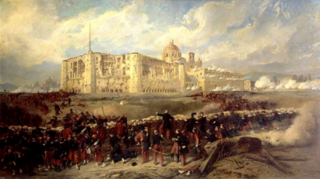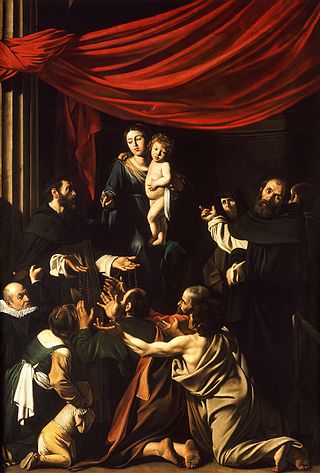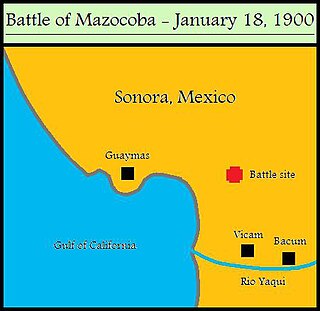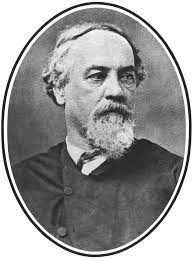Sources
- Spicer, Edward H. Cycles of Conquest. Tucson: University of Arizona Press, 1962.
Juan Banderas (executed 1833 at Arizpe) was the leader of the Yaqui during part of the Yaqui Wars, specifically from 1825 until 1833.
Banderas came to the leadership of the Yaqui when they opened war against Occidente State due to opposition to threats of taxation and ending of their sovereignty. Banderas was able to convince the Mayos, Opatas and Pimas to join in the war against the Mexicans.
In 1827 Banderas' forces suffered defeat due to using primarily bows and arrows against the Mexicans guns. Banderas then negotiated a peace in which he was pardoned and made the captain-general of the Yaqui towns.
In 1829 Occidente instituted a new plan to tax the Yaqui and also to allot their lands. They also ended the office of captain-general. Banderas decided to wait until he had better weapons to act. By 1832 he had enough guns and gunpowder to feel confident of some success in war with the Mexicans. His force of 1,000 including Opatas under the command of Dolores Gutiérrez was defeated near Buenavista in 1833. He was then captured and executed.

Cajemé / Kahe'eme, born and baptized José María Bonifacio Leyba Pérez, was a prominent Yaqui military leader who lived in the Mexican state of Sonora from 1835 to 1887. Kahe'eme (Cajemé) is originally a family clan name, and was also used by Fernando Leyba, the father of José María Bonifacio Leyba Pérez.

The Yaqui, Hiaki, or Yoeme, are a Native American people of Arizona and Indigenous people of Sonora, Mexico. They speak a Uto-Aztecan language.

Cosalá is a small city and the seat of its surrounding municipality in the Mexican state of Sinaloa. It stands at 24°24′45″N106°41′30″W. The city reported 6,577 inhabitants in the 2010 census.

A mitrailleuse is a type of volley gun with barrels of rifle calibre that can fire either all rounds at once or in rapid succession. The earliest true mitrailleuse was invented in 1851 by Belgian Army captain Fafschamps, ten years before the advent of the Gatling gun. It was followed by the Belgian Montigny mitrailleuse in 1863. Then the French 25 barrel "Canon à Balles", better known as the Reffye mitrailleuse, was adopted in great secrecy in 1866. It became the first rapid-firing weapon deployed as standard equipment by any army in a major conflict when it was used during the Franco-Prussian War of 1870–71.
The Opata are an indigenous people in Mexico. Opata territory, the “Opatería” in Spanish, encompasses the mountainous northeast and central part of the state of Sonora, extending to near the border with the United States. Historically, they included several subtribes, including the Eudeve, Teguima, and Jova peoples.

The second French intervention in Mexico, also known as the Second Franco-Mexican War (1861–1867), was a military invasion of the Republic of Mexico by the French Empire of Napoleon III, purportedly to force the collection of Mexican debts in conjunction with Great Britain and Spain. Mexican conservatives supported the invasion, since they had been defeated by the liberal government of Benito Juárez in a three-year civil war. Defeated on the battlefield, conservatives sought the aid of France to effect regime change and establish a monarchy in Mexico, a plan that meshed with Napoleon III's plans to re-establish the presence of the French Empire in the Americas. Although the French invasion displaced the Juárez's Republican government from the Mexican capital and the monarchy of Archduke Maximilian was established, the Second Mexican Empire collapsed following Napoleon III's decision to withdraw French troops in 1867. Aided by the United States, whose four-year civil war ended in 1865, the Republican army in Mexico used material aid of the U.S. to invigorate the Republican fight against regime of Maximilian. France's 1866 decision to cease supporting Maximilian's regime militarily aided in the monarchy's collapse. Maximilian and two Mexican generals were executed by firing squad on 19 June 1867, ending this period of Mexican history.
Emilio Kosterlitzky was a Russian-born Mexican colonel during the Mexican Revolution. He had also served in the Mexican Apache Wars and Yaqui Wars. He is most noted for being the commander of the Mexican Rurales, or border police, during the late Nineteenth Century.

Estado de Occidente was a Mexican state established in 1824. The constitution was drafted in that year and the government was initially established with its capital at El Fuerte, Sinaloa. The first governor was Juan Miguel Riesgo. The state consisted of modern Sonora and Sinaloa, and also modern Arizona more or less south of the Gila River.

Nácori Chico is a small town in Nácori Chico Municipality in the east of the Mexican state of Sonora.

The Battle of Bear Valley was a small engagement fought in 1918 between a band of Yaquis and a detachment of United States Army soldiers. On January 9, 1918, elements of the American 10th Cavalry Regiment detected about thirty armed Yaquis in Bear Valley, west of Nogales, Arizona, a large area that was commonly used as a passage across the international border with Mexico. A short firefight ensued, which resulted in the death of the Yaqui commander and the capture of nine others. Though the conflict was merely a skirmish, it was the last time the United States Army and Native Americans engaged in combat and thus has been seen as the final official battle of the American Indian Wars.

The Mexican Border War, or the Border Campaign, refers to the military engagements which took place in the Mexican–American border region of North America during the Mexican Revolution. The period of the war encompassed World War I, and the German Empire attempted to have Mexico attack the United States, as well as engaging in hostilities against American forces there itself.

This article details the history of Sonora. The Free and Sovereign State of Sonora is one of 31 states that, with the Federal District, comprise the 32 Federal Entities of Mexico. It is divided into 72 municipalities; the capital city is Hermosillo. Sonora is located in Northwest Mexico, bordered by the states of Chihuahua to the east, Baja California to the northwest and Sinaloa to the south. To the north, it shares the U.S.–Mexico border with the states of Arizona and New Mexico, and on the west has a significant share of the coastline of the Gulf of California.

The Yaqui Wars, were a series of armed conflicts between New Spain, and its successor state, the Mexican Republic, against the Yaqui Natives. The period began in 1533 and lasted until 1929. The Yaqui Wars, along with the Caste War against the Maya, were the last conflicts of the centuries long Mexican Indian Wars. Over the course of nearly 400 years, the Spanish and the Mexicans repeatedly launched military campaigns into Yaqui territory which resulted in several serious battles and massacres.

The Battle of Mazocoba, or the Mazocoba massacre, was a major engagement of the Yaqui Wars that was fought in Sonora, Mexico. On January 18, 1900, a Mexican Army expedition encountered hundreds of Yaqui renegades about twenty miles east of Guaymas. During the battle that followed, several hundred people were killed or wounded and over 1,000 Yaquis were taken prisoner.

Antonio Pascual Narbona was a Spanish soldier from Mobile (Mauvila in Spanish) now in Alabama, who fought native American people in the northern part of Mexico around the turn of the nineteenth century. He supported the independence of Mexico from Spain in 1821. He was Governor of the territory of Santa Fe de Nuevo México from September 1825 until 1827.
Esfinge is the ring name of a Mexican Luchador enmascarado, or masked professional wrestler, currently working for the Mexican Consejo Mundial de Lucha Libre (CMLL) wrestling promotion. Esfinge's real name is not a matter of public record, as is often the case with masked wrestlers in Mexico where their private lives are kept a secret from the wrestling fans. He is the son of professional wrestler Magnum and the grand son of wrestler "Halcon Furia" and has previously also worked under the name "Halcon Furia Jr." Esfinge is Spanish for Sphinx.
Refugio Tánori was a Mexican soldier and a member of the Opata People. He was born in the town of Álamos in 1835.
The Revolución de los Ríos refers to an uprising lasting from 1867 to 1868 by the Mayo and the Yaqui people who lived along the Mayo and the Yaqui Rivers in Sonora, against the government of Mexico.

Ignacio Pesqueira García was a 19th-century Mexican general and politician. He was the Governor of Sonora over six times, with two of the six terms being an insurgent governor during the Second French intervention in Mexico.

Ángel Martínez, also known as the Machetero or El Machete was a Mexican general during the 19th-century. He had a prominent military career during the Second French intervention in Mexico, being a key commander across the state of Colima. He was also a major figure of the Yaqui Wars, notably ordering the execution of Cajemé.